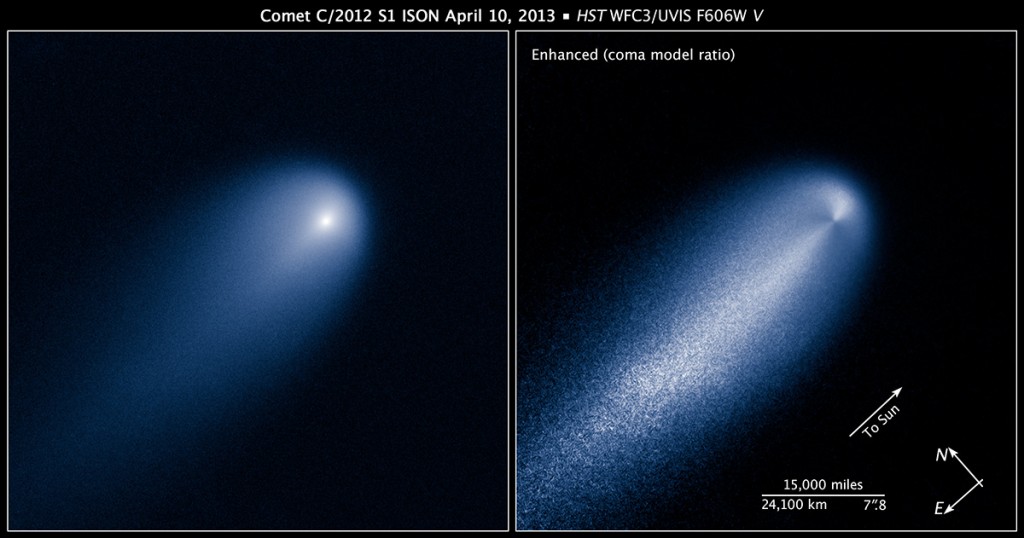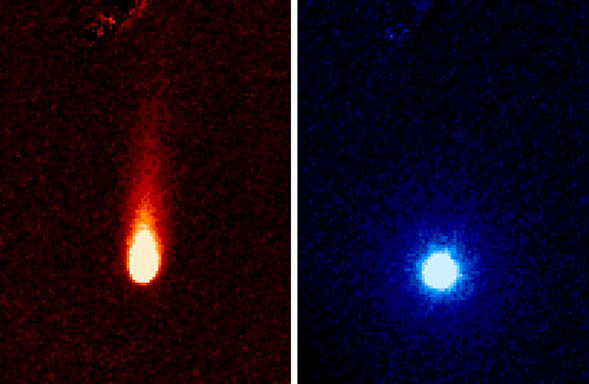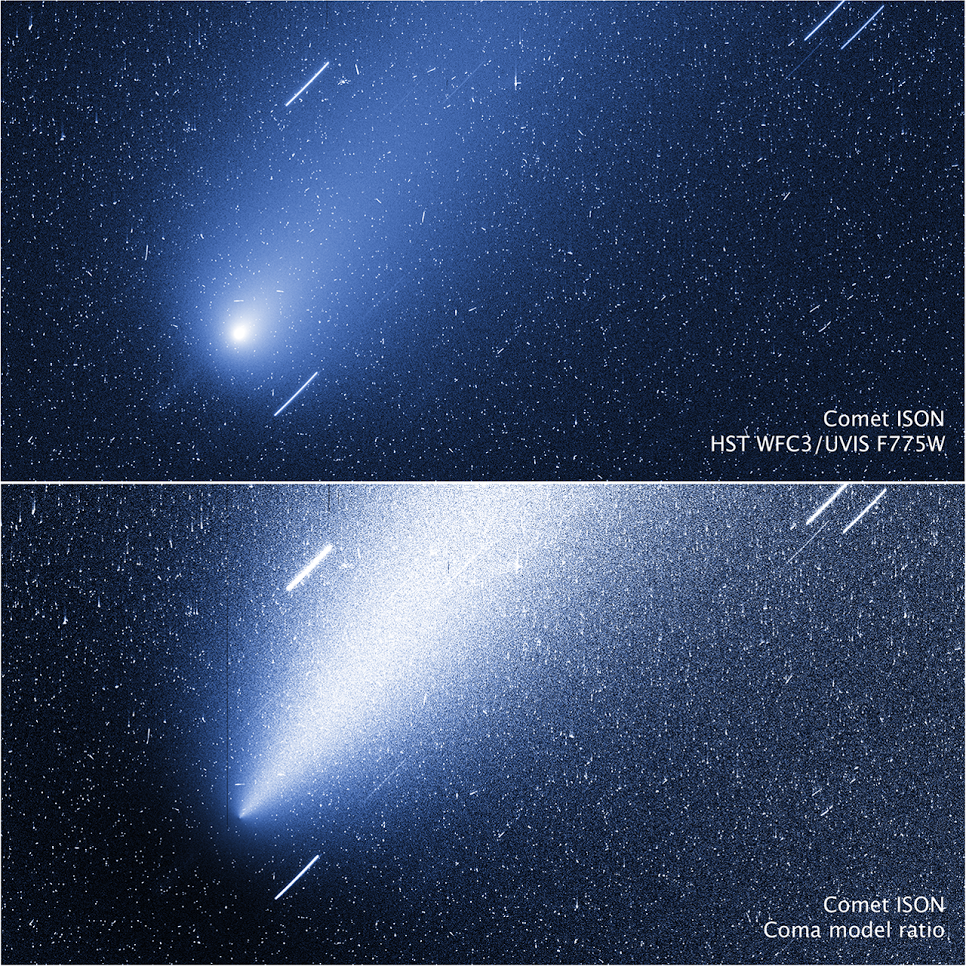Hubble Space Telescope Observations
Comet ISON is coming around the Sun for the first time in its life. On November 28, 2013, it will pass the closest point from the Sun at merely 1.7 solar radii from the Sun’s surface. The comet is predicted to be extraordinarily bright then, albeit too close to the Sun to be directly seen by eye at its brightest.
We observed ISON with the Hubble Space Telescope on April 10, 2013. Below is the image acquired with the Wide Field Camera 3 through a broadband filter in the visible light. With the extremely high spatial resolution of Hubble, we were able to resolve the fine structure in the coma that are difficult to see with most other ground-based telescopes. Read more about the results: CBET #3496.

The left panel shows the comet as observed through F606W filter. The right panel shows an enhanced image that reveals the jet coming out from the nucleus and extending towards the sunward direction. Credit: NASA/ESA/Z. Levay (STScI).
Here is a summary of the main results from these images:
- The dust coma is mostly composed of sub-µm-sized particles emitted at speeds of tens of meters per second.
- The A(θ)fρ, a quantity to measure the dust production rate, is 1339 and 1239 cm in the F606W and F438W filters, respectively, in apertures <1.6″ in radius.
- The dust colors are slightly redder than solar, with a slope of 5.0±0.2% per 100 nm, and increase to >10% per 100 nm 10,000 km down the tail. The color properties of ISON’s coma is similar to that of Comet Hale-Bopp.
- A sunward jet is about 1.6″ long, at a position angle of 291°, with an opening angle of ~45º. The shape and orientation of the jet does not change over 19 hours of our observations, suggesting a circumpolar jet.
- The jet indicates that the rotation pole is pointing within 30° of (RA, Dec) = (330°, 0°).
There are two interesting implications from our observation:
- The existence of ice grains in the inner coma is the best explanation we could find for the change of color within the coma.
- The comet always faces the Sun with one side, and the other side is always in dark, therefore probably still retaining abundant supervolatiles (CO and/or CO2). This situation won’t change until the last week before perihelion. When the original night side is suddenly exposed to strong sunlight at within Mercury’s orbit, large outbursts might be triggered.
While we are continuing our analysis, we were able to put an upper limit of the radius of the nucleus as 2 km from our images.
For more details about our results, please wait a few weeks until our paper reporting these observations comes out.
Spitzer Space Telescope Observations
In addition to the Hubble observations, we also used the Spitzer Space Telescope to observe ISON on June 13 in the near-infrared wavelengths, showing the gas coma around ISON, most like composed of CO2. Read more about the results: CBET #3598.

The left panel is ISON as seen in the near-infrared. The right panel is the gas coma around ISON, most likely composed of CO2. Credit: NASA/Caltech
Other planned observations that I’m involved
Mars Reconnaissance Orbiter (MRO) and Curiosity Rovers
ISON passed by Mars at 0.07 AU (10 million km) on October 1, 2014. Right before and during the flyby, the high-resolution camera, HiRISE onboard the Mars Reconnaissance Orbiter, took images of the comet. Here is the link to the early release of those images.
The Mars Science Laboratory, Curiosity Rover, was also planning to observe the comet during the close flyby. But it is much more difficult for Curiosity than for MRO. We are anxiously awaiting their results!
Hubble Space Telescope
Hubble took several more images on October 9, and will take more images and spectra of the comet before ISON moves too close to the Sun. In addition, there are some more observations planned in December 2013 and January 2014, after ISON passes its perihelion, if it survives the extreme heat and gravity of the Sun.
New images of ISON from Hubble
The new images from Hubble taken on October 9 was released and posted on line by the Space Telescope Science Institute (link). It is clearly seen from the color image that the out skirt of the coma appears bluer than the inner core. This is because a large amount of gas is released from ISON right now, under the heat of the Sun. These gases expands to larger volume than the small dust blowed out from the comet by gas. Compared to dust, gas appear to be blue-greenish.
Many people are looking, in these new images, for the beautiful jet that extended roughly towards the direction of the Sun seen in the Hubble images taken in April (see above image). And to our disappointment, there is nothing obviously jet-like on the side that is towards the Sun.

The top image is the image of ISON taken by Hubble on October 9. The bottom image is an enhancement to reveal the non-symmetric structures in the coma, such as jet. Credit: NASA/ESA/Z. Levay
Is this a surprise? Or something wrong? Not at all. It is in fact consistent with our measurement of the orientation of the jet from the April images. Based on our previous analysis, we don’t expect that the jet to change significantly or shut off. However, compared to April, we are looking at the comet from the Earth from a very different angle. From this angle, the jet is almost pointing towards us, and slightly towards north-northwest, i.e., in the tail. So that jet is not supposed to appear on the sunward side of the comet, and its boundary would appear to be much more blur than it is in April.
A little bit regretful, though, because this angle doesn’t help us to refine the previous measurements. But our viewing angle is changing rapidly in this month. Based on my calculation, the jet should appear near the sunward direction by the end of October and early November, although still almost point towards us. Hopefully when Hubble captures ISON next time before it disappears in the Sun’s glare, we could spot the jet again. Of course, no one should be surprised if a prediction about a comet fails, because we just know too little about comets.
Can we see ISON without a telescope?
Here is what some of my colleagues and I think about what we might see in late November – early December when ISON is close to and just passes perihelion. No matter its fate, it may still be able to develop a long dust tail that stretches up from the horizon, and bright enough to be directly visible without using a telescope or a binocular. Remember Comet Lovejoy in 2011, which has a small nucleus of probably 400 m in radius and had a sungrazing perihelion similar to ISON. It broke up completely hours to a few days immediately after perihelion. But it still put up a great show in the southern hemisphere. Now it’s our northern hemisphere residents’ turn!
Read more about ISON:
Blogs:
Websites:
- Wikipedia ISON page
- Minor Planet Center ISON database
- NASA Comet ISON Observing Campaign
- NASA Comet ISON Toolkit
- HubbleSite ISON Blog
Relevant Publications